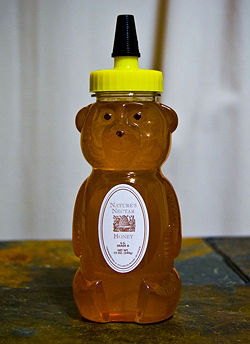Bear-shaped honey bottle: Difference between revisions
imported>Joe Quick No edit summary |
mNo edit summary |
||
| (7 intermediate revisions by 4 users not shown) | |||
| Line 1: | Line 1: | ||
{{subpages}} | {{subpages}} | ||
[[Image:Honeybear.jpg|right|thumb|250px|{{#ifexist:Template:Honeybear.jpg/credit|{{Honeybear.jpg/credit}}<br/>|}}]] | [[Image:Honeybear.jpg|right|thumb|250px|{{#ifexist:Template:Honeybear.jpg/credit|{{Honeybear.jpg/credit}}<br/>|}}]] | ||
Many honey producers market their products in '''bear-shaped | Many [[honey]] producers in the [[United States of America|United States]] market their products in '''[[bear]]-shaped [[bottle]]s''' that have come to be popularly known as "honeybears." In fact, a survey conducted in 1995 showed that some 15.5 percent of the honey sold was packaged in such bottles.<ref>Laurian J. Unnevehr and Fatoumata C. Gouzou. 1998. Retail Premiums for Honey Characteristics. Agribusiness 14(1):49-54.</ref> The practice reportedly dates back to 1957 when [[Ralph Gamber]], future president of the [[Dutch Gold Honey company]], reasoned that "a bear likes honey, why not a bear of honey?"<ref>Bears celebrate 40 years of holding honey. ''The News and Record'', May 19, 1997.</ref> | ||
As with many such ideas, the origin of bear shaped honey bottles is not totally clear-cut. Edward Rachins, for example, applied for a patent on a bear-shaped bottle several years before Gamber hit upon his idea.<ref>Edward Rachin. 1950. Bottle | As with many such ideas, the origin of bear-shaped honey bottles is not totally clear-cut. [[Edward Rachins]], for example, applied for a patent on a bear-shaped bottle several years before Gamber hit upon his idea.<ref>Edward Rachin. 1950. Bottle or similar article. [http://www.google.com/patents?id=FIZzAAAAEBAJ U.S. Patent D166995]</ref> It was Gamber's company, however, that popularized the honeybear. [[Plastic]]s were not yet as ubiquitous or as easily produced as they are today and the idea was a gamble but it immediately paid off;<ref>Honey firm finds bull market for its bear-shaped jars. ''Central Penn Business Journal'', Dec 18, 1998.</ref> honeybears quickly became an American cultural [[icon]]. In the fall of 2007, Dutch Gold held a naming contest for the honeybear and the Gamber family selected "Nugget" from among the entries.<ref>[http://www.dutchgoldhoney.com/store/community_events.asp Dutch Gold Community Events] Retrieved July 11, 2008.</ref> | ||
Today, one may find a variety of shapes and sizes of bear-shaped honey bottles on the shelf | Today, one may find a variety of shapes and sizes of bear-shaped honey bottles on the shelf at [[grocery store]]s or online. There are even websites where one may buy unused bear bottles for packaging and selling one's own products. | ||
== | ==Footnotes== | ||
{{reflist|2}}[[Category:Suggestion Bot Tag]] | |||
Latest revision as of 11:00, 17 July 2024
Many honey producers in the United States market their products in bear-shaped bottles that have come to be popularly known as "honeybears." In fact, a survey conducted in 1995 showed that some 15.5 percent of the honey sold was packaged in such bottles.[1] The practice reportedly dates back to 1957 when Ralph Gamber, future president of the Dutch Gold Honey company, reasoned that "a bear likes honey, why not a bear of honey?"[2]
As with many such ideas, the origin of bear-shaped honey bottles is not totally clear-cut. Edward Rachins, for example, applied for a patent on a bear-shaped bottle several years before Gamber hit upon his idea.[3] It was Gamber's company, however, that popularized the honeybear. Plastics were not yet as ubiquitous or as easily produced as they are today and the idea was a gamble but it immediately paid off;[4] honeybears quickly became an American cultural icon. In the fall of 2007, Dutch Gold held a naming contest for the honeybear and the Gamber family selected "Nugget" from among the entries.[5]
Today, one may find a variety of shapes and sizes of bear-shaped honey bottles on the shelf at grocery stores or online. There are even websites where one may buy unused bear bottles for packaging and selling one's own products.
Footnotes
- ↑ Laurian J. Unnevehr and Fatoumata C. Gouzou. 1998. Retail Premiums for Honey Characteristics. Agribusiness 14(1):49-54.
- ↑ Bears celebrate 40 years of holding honey. The News and Record, May 19, 1997.
- ↑ Edward Rachin. 1950. Bottle or similar article. U.S. Patent D166995
- ↑ Honey firm finds bull market for its bear-shaped jars. Central Penn Business Journal, Dec 18, 1998.
- ↑ Dutch Gold Community Events Retrieved July 11, 2008.
